This inspiring story is of a rising startup called WoodSpoon, started by Oren Saar and Merav Kalish Rozengarten. WoodSpoon is a community-based online platform that connects diners with trusted home chefs to deliver delicious authentic homemade food. Customers can order online to enjoy a variety of dishes from local cooks specializing in cultural cuisine. To meet diners’ demand for less industrial food, we built a sustainable platform to enable chefs to join the gig economy. Here is the story of WoodSpoon in Oren and Merav’s own words.
Introduce us to the idea of WoodSpoon
We are changing the food delivery business by putting chefs front and center. By providing a sustainable platform to enable chefs to join the gig economy, they can do what they do best -cook high quality, delicious food for diners. We have seen demand for home-cooked food grow tremendously in recent years, and we developed a two-sided platform where both chefs and diners can benefit.
What’s your strategy story? What led you to start WoodSpoon?
First, we love to cook and share food with others! Second, when we moved to New York from Israel, we craved authentic food that reminded us of home. We started exploring ways to create a network for home-cooked meals to give diners a “taste of home,” and we found that we weren’t alone in that mission. There is a tremendous demand for authentic, homemade food in communities around the U.S.
Our vision is to connect people through food. We are a team of immigrants, each with our own unique culture and food, and we want to bridge cultural gaps and empower communities to preserve their heritage and share it with others.
What marketing, operation strategies are you adopting at WoodSpoon?
Like Airbnb and Uber, WoodSpoon delivers the technology that allows chefs to work in today’s digital marketplace. That also enables us to improve the economics of delivery services and build close relationships with our chefs and customers. Our model is different from food delivery apps. Our low-cost fee structure ensures chefs are treated fairly, and customers can get authentic homemade food at affordable prices.
Any strategy mistakes you have made and what did you learn?
We are always learning and adapting to changes in the marketplace and overall business environment. When COVID-19 hit, our platform was still in its beta stages, with only dozens of chefs in the borough of Manhattan. We were not planning to launch the full app until a year, but we soon found ourselves with a waitlist of over 1000 new chefs. We understood that it is our time, and we wanted to support all those chefs who lost their jobs overnight. We had to rise to the challenge. Being able to adapt to this changing environment quickly was a big win for us.
Finally what advice do you have for your fellow entrepreneur readers?
Take advantage of the resources available to you. As a community-based company, we are fortunate to be backed and supported by a strong community. The same can be said for mentors. It is helpful to have a local on-the-ground network that can help connect and guide you as you build your business.
Disclaimer: The information in the above story is provided by the startup and The Strategy Story takes no responsibility for the authenticity of the product and services offered by the startup. Reader’s discretion is advised.
Check out stories of other aspiring Entrepreneurs
Also, check out our most loved stories below

Johnnie Walker – The legend that keeps walking!
Johnnie Walker is a 200 years old brand but it is still going strong with its marketing strategies and bold attitude to challenge the conventional norms.

Starbucks prices products on value not cost. Why?
In value-based pricing, products are price based on the perceived value instead of cost. Starbucks has mastered the art of value-based pricing. How?

Nike doesn’t sell shoes. It sells an idea!!
Nike has built one of the most powerful brands in the world through its benefit based marketing strategy. What is this strategy and how Nike has used it?

Domino’s is not a pizza delivery company. What is it then?
How one step towards digital transformation completely changed the brand perception of Domino’s from a pizza delivery company to a technology company?

BlackRock, the story of the world’s largest shadow bank
BlackRock has $7.9 trillion worth of Asset Under Management which is equal to 91 sovereign wealth funds managed. What made it unknown but a massive banker?

Why does Tesla’s Zero Dollar Budget Marketing Strategy work?
Touted as the most valuable car company in the world, Tesla firmly sticks to its zero dollar marketing. Then what is Tesla’s marketing strategy?

The Nokia Saga – Rise, Fall and Return
Nokia is a perfect case study of a business that once invincible but failed to maintain leadership as it did not innovate as fast as its competitors did!






